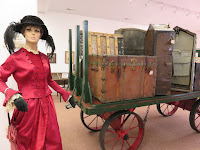The Blue Charley Chronicles has moved! Please visit the new site at The Blue Charley Chronicles – Roadside attractions, small towns, museums, and more from the USA
The man is Gary Greff. He returned to his hometown of
Regent, North Dakota, in 1989 to find a town and community withering on the
vine. He also had a chance encounter with a small metal sculpture made by a
local farmer. Greff, a former teacher and principal, set to work on building a scrap
metal sculpture of his own despite having no welding experience. And this
sculpture was super-sized, a farming family of three towering over miles of
rust-colored fields.
Titled “World’s Largest Tin Family” and finished in 1991, it was the first of many Greff envisioned dotting the modest road between Gladstone, which nestles against Interstate 94, and Regent, which had a population of 266 in 1990. With the sculptures, he reasoned, would come tourists. The towns could build businesses to cater to the tourists. And Regent and Gladstone, among others, would become destination towns rather than forgotten blips on the North Dakota map.
Every three years or so another followed: “Teddy Rides Again”
(1993), “Pheasants on the Prairie” (1996), “Grasshoppers in the Field” (1999), “Geese
in Flight” (2001), “Deer Crossing” (2002), and “Fisherman’s Dream” (2006). The
next that was to be installed, “Spider’s Web,” has been held up by land rights
issue, so Greff has since turned his attention to creating a knight and dragon
sculpture to be placed in front of his Enchanted Castle, a hotel in Regent that
serves as a resting stop at the end-point of the highway.
The sculptures are expensive, and Greff relies mostly on tourists’ donations and gift shop purchases to fund the project. The humble and down-to-earth artist still has to find time to create new works in between managing an RV park and taking care of the existing sculptures, the gift shop, and the hotel.
Every sculpture is intentional, not just whims of fancy. “World’s
Largest Tin Family” represents the farmers of his community; “Teddy Rides Again”
is a nod to North Dakota’s influence on our 26th President; “Pheasants
on the Prairie,” “Grasshoppers in the Field,” “Deer Crossing,” and “Geese in
Flight” all portray creatures which define the region; and “Fisherman’s Dream”
takes place on a prairie pond (yes, fishing does take place in North Dakota—according
to the state’s tourism website it has particularly fine waters for walleye).
The Enchanted Highway draws tourists from around the globe,
and despite features in The New York
Times, The Wall Street Journal, People, and others, the much-needed
extra source of funding is still lacking. Regent’s population, meanwhile, has
dipped, wavering between 159 and 172 from July 2010 to July 2016. The downtown
strip is sparse, consisting of little more than the gift shop, a food co-op, a
Sinclair gas station, and a saloon.
Yet there’s no doubt concerning Greff’s commitment to the
project, and just how much it all means to him. It’s his baby, right down to
the Enchanted Highway cap he wears. When I am lucky enough to meet him in
person, he is stands outside his home along with two other men. He gives me a
hearty handshake and asks me where I’m from. I have to tell him just how
impressed I am.
“It wasn’t high on the list of things to do in my life,”
Greff jokes. “You never know what direction it’s going to go. I came back home,
saw that the town was dying, and the next thing you know I go, ‘Well, let’s
start this.’
“We were a farming community, and all the farms got bigger
and bigger and bigger and we had less and less people on the farms, and less
kids and the school closed, so pretty quick…you ain’t got the people no more.
So either gonna die or you’re going to do something different. Every town wants
a big factory…well a town of 100 ain’t gonna get a factory. I saw that the road
from Interstate to here was paved that same year. I said, ‘Now I got a paved
road. Now I should be able to get people from point A to point B some way.’
“Then a local farmer out of town made a small man holding a
bale up, out of metal. And then it dawned on me. That’s what the ranchers and
farmers in the Midwest are good at, they’re good at welding. We can use it to
our advantage. But no one’s going to stop for normal. But they might stop for
the world’s largest. And that’s how it all started. I started welding and 28
years later I’m still welding.”
My recording inadvertently shut down at this point. The
conversation shifted to the unsettling matter of the need for state funding—and
the difficulty of leading an ordinary life while maintaining an extraordinary
creation. Indeed, it’s painfully obvious that the vision has not really come to
fruition. Polarizing thoughts came to mind: these majestic creations need to be
preserved and deserve state funding and protection; and western North Dakota is
so remote it is just hard to imagine anything here becoming a true tourist
destination.
Greff’s vision may be considered a bit grandiose or
unrealistic, but you can’t fault him for trying. And he continues to be radically
dedicated to that vision while remaining unassuming, as if the vision has run
away from the creator.
“There’s people that still come out and say that they really
enjoy the sculptures,” Greff told The
Dickinson Press. “I think, ‘Well, it must mean something to somebody’…I’ve
put a lot of sweat and work and a lot of everything into this. Until they bury
me, I’m going to keep working on this project and other projects that I might
have. I’ve got a lot of things I’m up dreaming about at night that I want to
see done.”
Additional sources:
http://www.thedickinsonpress.com/progress/4237155-despite-struggles-gary-greff-never-giving-enchanted-highway-project
http://www.roadsideamerica.com/story/2155
https://www.usatoday.com/story/travel/destinations/2013/08/02/enchanted-highway-sculptures-north-dakota/2603189/
http://www.myndnow.com/news/dickinson-news/gary-greff-i-need-help-with-enchanted-highway/550924694























































